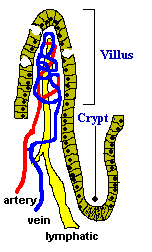VIVO Pathophysiology
Villi, Crypts and the Life Cycle of Small Intestinal Enterocytes
If examined closely, the lumenal surface of the small intestine appears similar to velvet due to its being covered by millions of small projections called villi which extend about 1 mm into the lumen. Villi are only the most obvious feature of the mucosa which houses a dynamic, self-renewing population of epithelial cells that includes secretory cells, endocrine cells and the mature absorptive epithelial cells which take up nutrients from the lumen and transport them into blood, fulfilling the basic function of the digestive system. Understanding how the small intestine functions requires looking at the structure of the mucosa in more detail.
Epithelial Cell Dynamics

The mucosa of small intestinal mucosa is arranged into two fundamental structures:
Villi are projections into the lumen covered predominantly with mature, absorptive enterocytes, along with occasional mucus-secreting goblet cells. These cells live only for a few days, die and are shed into the lumen to become part of the ingesta to be digested and absorbed. That's right, we're all really cannibals.
Crypts (of Lieberkuhn) are moat-like invaginations of the epithelium around the villi, and are lined largely with younger epithelial cells which are involved primarily in secretion. Importantly, toward the base of the crypts are stem cells, which continually divide and provide the source of all the epithelial cells in the crypts and on the villi.
The system described above is really quite elegant. Stem cells in the crypts divide to form daughter cells. One daughter cell from each stem cell division is retained as a stem cell. The other becomes committed to differentiate along one of four pathways to become an enterocyte, enteroendocrine cell, goblet cell, tuft cell or Paneth cell. Cells in the enterocyte lineage divide several more times as they are pushed out of the crypts, actively migrate onto and along the villi, differentiate further into the mature absorptive cells that express all the transport proteins and enzymes characteristic of those cells. To put it another way, enterocytes are born at the bottom of the crypts, pass through childhood migrating up the walls of the crypts, then settle down briefly to enjoy an absorptive adulthood on the villi.
Inside the Villus
Virtally all nurtients, including all amino acids and sugars, enter the body across the epithelium covering small intestinal villi. As shown in the diagram above, each villus contains a capillary bed and a blunt-ended lymphatic vessel referred to as the "central lacteal".
After crossing the epithelium, most of these molecules diffuse into a capillary network inside the villus, and hence into systemic blood. Some molecules, fats in particular, are transported not into capillaries, but rather into the lymphatic vessel, which drains from the intestine and rapidly flows into blood via the thoracic duct.
Details of the transport of major nutrients into the capillaries or lymphatics in the villi are presented in subsequent sections.
Updated September 2019. Send comments to Richard.Bowen@colostate.edu

